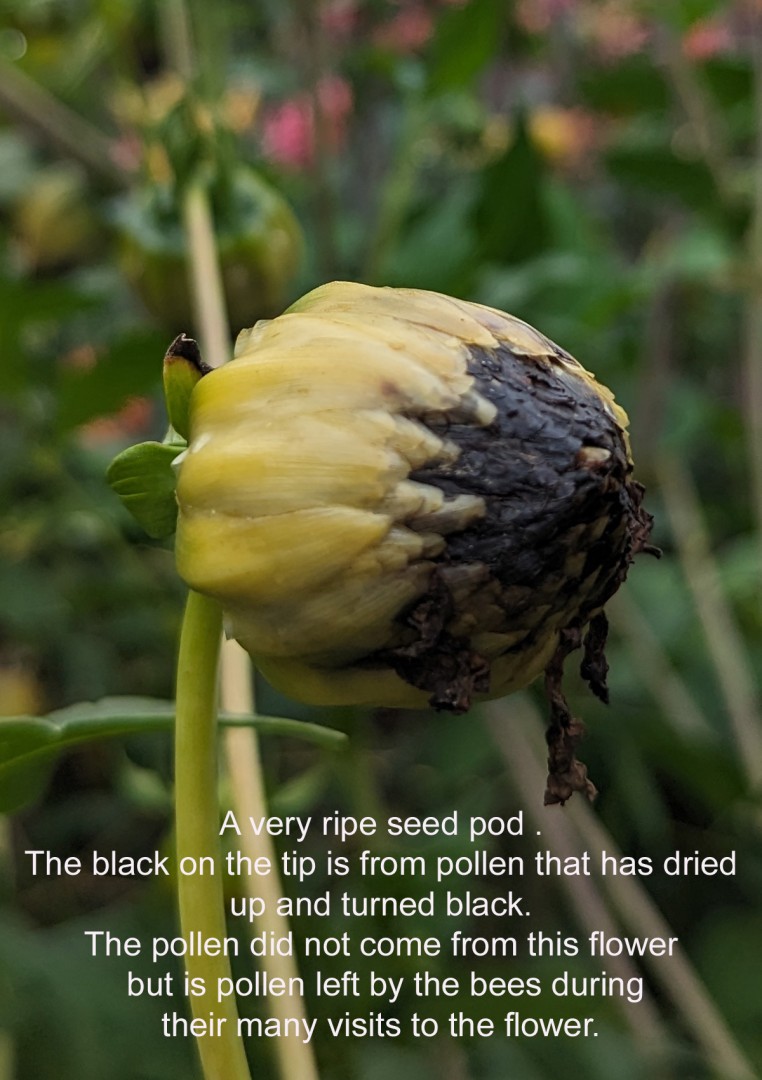Article 
I updated for the PNDC Newsletter coming out soon.
Harvesting Dahlia Seeds
by Ted J. Kennedy
The late Bill Mishler was member of our club and founded our trial garden. He was a dahlia breeder who specialized in small formal decorative dahlia and similar types but he became famous for his Woodland's Wild Thing. Bill was a pragmatic seed collector. He did not believe much in labeling seeds and he mixed all his seeds together and stored them in pint sized canning jars under the vanity in the bathroom. He dried his seeds by hanging bundles of seeds with their stems upside down in his unused bedroom and many of the seeds were those that he swept up off of the floor. I tell you this story because harvesting and storing seeds is not rocket science and if you want to try to grow some seedlings, it can be a fun and easily done experiment.
The most obvious practice is that you must not deadhead your flowers to get rid of spent blooms. That sounds awfully basic but many people have this habit built into their sub conscious minds. I have had people visit our gardens and start to deadhead plants “as a favor” to me not even thinking that those spent flowers were being saved to make seeds. It takes about 3-5 weeks(depending on the size of the pod with small ones ripening first) from the time when the pod closes up and no longer accepts pollen for the pod to ripen here is a basic time line:
Step(1): the yellow pollen center appears in an “overipe” flower.
Step(2) about 2 days later the pollen center sends up it’s pollen stamens with it’s anthers that produce and distribute the pollen. Note that the male parts of the flower appear first and the flower stops producing pollen when the female structures appear in the same area. Pollen is now being harvested by the bees and you may never see the pollen at this stage as they grab all of it.
Step (3) the pistils appear and they resemble tiny flowers. They are receptive for pollen for a few hours each day. There are as many a hundred pistils or more that form over the course of a few days.
Step (4) after the pistils stop appearing the flower goes through the ripening process that lasts about 3-5 weeks. During this time the seeds inside the pod change color. They start out as white, turn green then tan or brown and finally either a dark brown or usually black. They can be inspected by peeking into the pod and looking at the color.
Step (5) the seed pods are harvested either at the stage when the seeds are ripe as above or can be left on the bush to further ripen as the pod itself turns color. The pod goes from green to a light brownish green and eventually turns brown. In Oregon in late September and all of October is when we collect most of our seeds. In dry weather, leave the seed pods on the plants until you are sure they are ripe. If there is lots of rain you may want to inspect the ripening pods on your most important seed parents and if they have some rot, you may want to harvest them a bit early.
The next step is shucking(removing the seeds) from the pod. We do it within a few days of harvesting and do not want the seed pod to dry out. Dry seed pods have what is called chaff and shucking dried seed pods is an overly messy process that we avoid.
Seeds from fully double dahlias have a germination rate of about 20% for us but that is an average and it varies from 0%(probably about 33% of batches of seeds will not sprout) to as high as about 75%. For us a batch of seeds that sprouts at about a 40% rate is a home run. Seeds should be dried completely and labeled and then stored in small envelopes in the freezer(protected from frost perhaps in a quart glass jar or in several plastic bags within a bag). They will last for over 10 years if you store them in the freezer whereas seeds stored at room temps sprout well for only about 2 years and very few sprout when older than 3 years. Dick Parshall of Clearview Dahlias grew several of his 2002 seeds this year as he stores them in the freezer.
